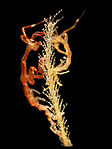Caprella mutica, commonly known as the Japanese skeleton shrimp, is a species of skeleton shrimp. It is a relatively large caprellids, reaching a maximum length of 50 mm (2.0 in). The species is sexually dimorphic, with the males usually being much larger than the females. It is characterised by their "hairy" first and second thoracic segments and the rows of spines on their bodies. Body colour ranges from green to red to blue, depending on the environment. It is an omnivorous, highly adaptable, opportunistic feeder. In turn, it provides a valuable food source for fish, crabs, and other larger predators. C. mutica is usually found in dense colonies attached to submerged man-made structures, floating seaweed, and other organisms.
C. mutica is native to shallow protected bodies of water in the Sea of Japan. In as little as 40 years, it has become an invasive species in the North Atlantic, North Pacific, and along the coasts of New Zealand. It is believed to have been accidentally introduced to these areas through the global maritime traffic and aquaculture. Outside of its native range, C. mutica is often exclusively synanthropic, being found in large numbers in and around areas of human activity. Its ecological and economic impact as an invasive species is unknown, but it poses a serious threat to native populations of skeleton shrimp in the affected areas. (Full article...)
